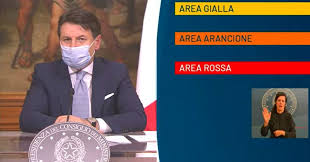Coronavirus: Italy’s R rate falls but red and orange zones unchanged

Rome: Italian Health Minister Roberto Speranza has renewed Covid-19 measures in six Italian regions until at least December 3.
Current measures were extended in Calabria, Lombardy, Piedmont, Puglia, Sicily, and Valle d’Aosta.

They are mostly high-risk red zones, apart from Puglia and Sicily which are orange, or moderate risk.
Speranza didn’t mention other regions, but Italian media reports that their classifications will stay in place until next week, as the health ministry is set to review restrictions every two weeks.
The new ordinance is valid until December 3rd, when Italy is due an update to the current set of emergency measures.
Restrictive measures “are the only real tool we now have to lower the contagion and get it under control,” Speranza said at a press conference on Friday afternoon.
“The data we are starting to receive give a glimpse of the light at the end of the tunnel, but we must keep a prudent approach.”
Speranza said the tiered system of restrictons, in place since November 6th, is to thank for a drop in the R number (which shows the coronavirus transmission rate) in the last week.
Italy’s R rate is down from 1.4 to 1.18 among symptomatic cases, the Higher Health Institute (ISS) and health ministry said in their weekly monitoring report announced.
The report has not yet been published, but health experts said in a press conference that most Italian regions and provinces now have an average R rate of between 1 and 1.25, they said, and the rate has dropped to below 1 in some regions and provinces this week.
However, the epidemic remains at “critical levels” in Italy, the report said, with a risk of an “uncontrolled epidemic” in 17 of the 20 regions.
The prospect of easing restrictions over the Christmas holidays was not discussed at the press conference, though experts recommended hard-hit regions tighten measures for now.
“We worry about the upcoming holidays, but now we have a duty to analyse what will happen at Easter if this second wave is not properly suppressed,” said Massimo Galli, Director of Infectious Diseases of the Luigi Sacco Hospital in Milan.
He said the worst-hit areas must “find a way to maintain rules, at least until the vaccine arrives, or the third wave is a foregone conclusion.”





